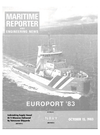
Page 40: of Maritime Reporter Magazine (October 15, 1983)
Read this page in Pdf, Flash or Html5 edition of October 15, 1983 Maritime Reporter Magazine
NATO Frigates (continued from page 36) tion radar, and a Lockheed STIR (modified SPG 60) illuminator ra- dar for controlling the M13 missile launcher and the 76-mm gun. The
European frigates, following the system redundancy principle, gen- erally have a radar for each weap- ons system.
The propulsion plant is a
COGAG installation with two
General Electric LM 2500 40,000 total shp driving a single shaft.
The Perry Glass is fitted with two retractable propeller pods aft of the sonar dome to improve berthing maneuvering and to pro- vide take-home power in the event of damage to the main engines or to the the propeller shaft. Each pod has a 325-hp motor to provide
Write 820 on Reader Service Card a speed of 10 knots. Maximum speed is 29 knots and range is 4,500 miles at 20 knots.
Four frigates of the Perry Class were ordered by the Royal Austra- lian Navy. Three of them, known as the Adelaide Class, are now in service; six additional "simplified" ships are planned for construction under licence in Australia at Wil- liamstown to replace the River
Class.
Three ships of the Perry Class are building under licence in Spain by Bazan de Construcciones Na- vales Militares at Ferrol for com- pletion in 1985-87; two more have been approved for probable com- pletion in 1988. The Spanish ver- sion will be faster and will include some modifications to the weapons systems, with the Harpoon sur- face-to surface missile launchers mounted on the upper deck and a 20-mm multi-barrel Meroka sys- tem in place of the Phalanx CIWS.
To sum up, this wide range of design differences has been the disappointing outcome of the NATO
Project Group II study that envi- sioned a common type of frigate for the 1970s. Of the 14 navies analyzed, there were 11 different ship types with wide variations in the weapons systems, electronics, propulsion plants, etc. On the other side there are the Warsaw Pact fleets where ships, armament, electronics and propulsion plants are all of Russian origin with a very high level of standardization.
In late 1980 a new NATO Group was established to study "Frigate
Replacement 90." This program is aimed at having new ships enter- ing service towards the mid-1990s.
These vessels are not intended to replace the present generation frigates described above, which at that time will be between 10 and 15 years old, but rather to fill other replacement needs such as the German Homburg and Lutjens
Classes, the Dutch Von Speijjk
Class, the British Leander Class, the U.S. Knox Class, and others.
Seven countries—Canada, France,
Germany, Italy, Netherlands,
United Kingdom and United
States—have agreed to participate in the project, which envisions a
NATO antisubmarine frigate with a conventional hull. Of course, it remains to be seen if different na- tional requirements will allow for a common design, or at least a common list of guidelines.
Such an ambitious project has met with skepticism in most NATO countries. However, in December 1982 the first prefeasibility study demonstrated clearly that tremen- dous savings could be achieved if nations build the same type of warship—something on the order of $5.6 billion for 100 frigates over a 10-year period, about 21 percent of the total cost. Moreover, there should be further savings during the expected 25-year life span of these ships of some 12 percent in the cost of operating and main- taining them.
In making this study the design- ers were free to select equipment meeting the stated capability re- quirements from the full range of systems available in NATO coun- tries, including items that are not yet in production. The study was conducted with parametric anal- yses to demonstrate the relative effectiveness and impact on ship size, configuration and cost for each of the system concepts and alternative ship designs.
A Complete Line
Of Heavy-Duty
Filter/Water
Separators for large diesel engines or equipment requiring continuous operation 500BP for large diesel engines, storage facilities, island fuel pumps
Flow Rate: 1800 G.P H. .300 ^ DAHL
Flow Rate 175 G P.H 200SR
RECYCLER
Flow Rate: 65 G.PH.
Voltage: 110v AC 300DB5
RECYCLER
BLENDER
Flow Rate: 300 G.PH.
Voltage: 110v AC 200MFV (manifold w valves)
Flow Rate: 200 G.PH.
Dahl's proven, superior patented design removes virtually 100% of the water and dirt!
DAHL Ask your local diesel parts or service house, or contact Dahl direct. Dealer inquiries invited: write Depl HD
Convert waste diesel crankcase oil into fuel. Keeps storage tanks clean, extend service life of replaceable filter elements.
DAHL MANUFACTURING. INC. 2521 Railroad Ave.
P.O. Box 5 Ceres, CA95307 ("209) 538-1122 TELEX: 364412 INTR
MHW • 1 1 •» M
MLW t i 1
Aquatic
Marine Systems Inc.
P.O. Box 326
Williamsville, NY 14221
Phone 716-632-5477 Tlx 522613 ITS Inc TPA
T.N. Brinkworth, Sales Manager
Your
Marine Structures
Require A
Solid Foundation 1. Reinforced concrete encasements. 2. Crack repair by EPOXY enjection. 3. Plastic wrap to eliminate marine borer attack. 4. AMS offers a turn key contract for repair and protection of marine piling. 5. For immediate action we are only a phone call away. 6. Free brochures on request. 38 Write 676 on Reader Service Card Maritime Reporter/Engineering News

 39
39

 41
41
